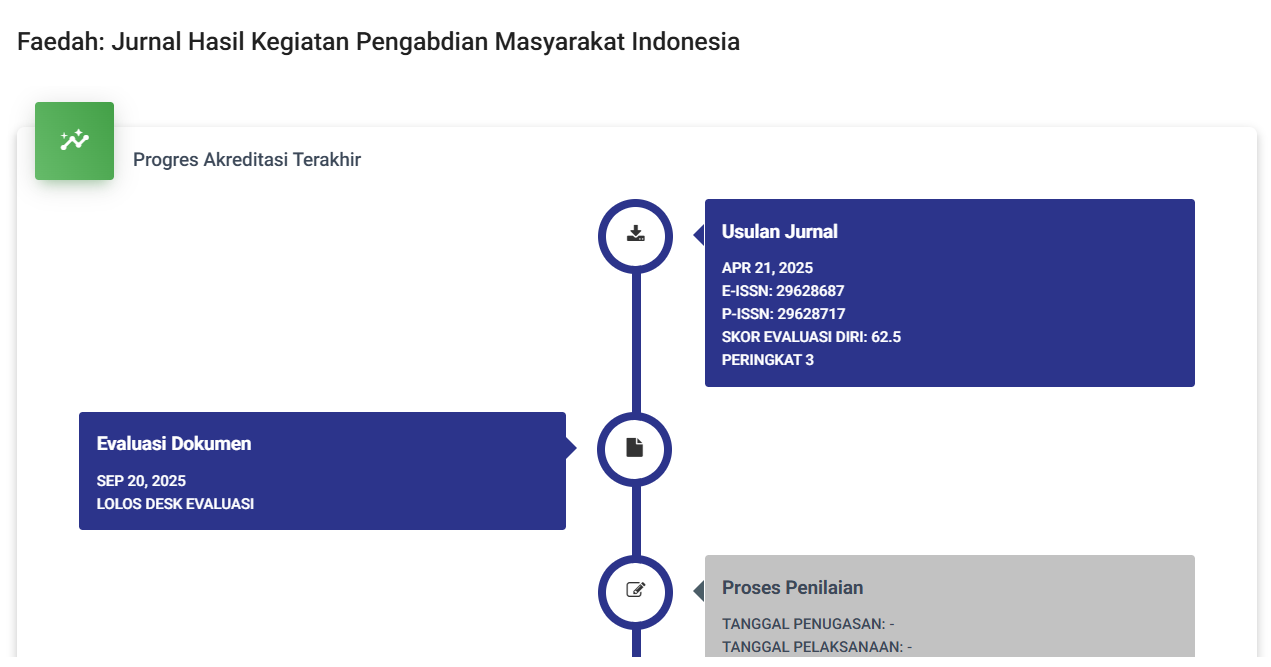Generasi Sehat Digital: Menavigasi Kewaspadaan Kesehatan Mental Dan Mengelola Kecanduan Gadget Di Kalangan Pelajar
DOI:
https://doi.org/10.59024/faedah.v2i1.716Keywords:
Gadgets, Navigate, StudentAbstract
Abstract and Keywords must be written Teens navigate a digital environment that never sleeps, leading to potential disruptions in sleep patterns and overall health. The use of gadgets is increasingly widespread, as is the increase in gadget addiction among teenagers. The aim of this activity is to create a school environment that supports teenagers' social development without triggering unhealthy gadget addiction. In this way, teenagers can be guided towards conscious and self-responsible behavior in using devices. The awareness and awareness campaign will focus on how students can recognize the dimensions of gadget addiction and some of the signs and symptoms of mental disorders. The method of conveying information is carried out in the classroom in the form of a focus group discussion. Before the campaign is carried out, students will be given the SAS and PHQ9 forms as basic measuring instruments that detect the possibility of potential gadget addiction and mental disorders. Based on the results of addiction scores and mental health disorders, it shows that there is a significant correlation between addiction scores and mental health disorder scores with a p value <0.037. Even though the magnitude of this relationship is very weak linearly, several dimensions have a fairly clear cause and effect path, thus providing confirmation that excessive exposure to the use of digital devices will threaten the health of adolescents.
References
Abi-Jaoude, E., Naylor, K. T., & Pignatiello, A. (2020). Smartphones, social media use and youth mental health. CMAJ : Canadian Medical Association Journal = Journal de l’Association Medicale Canadienne, 192(6), E136–E141. https://doi.org/10.1503/cmaj.190434
Apisitwasana, N., Perngparn, U., & Cottler, L. (2018). Effectiveness of school- and family-based interventions to prevent gaming addiction among grades 4–5 students in Bangkok, Thailand. Psychology Research and Behavior Management, Volume 11, 103–115. https://doi.org/10.2147/PRBM.S145868
Beyens, I., Frison, E., & Eggermont, S. (2016). “I don’t want to miss a thing”: Adolescents’ fear of missing out and its relationship to adolescents’ social needs, Facebook use, and Facebook related stress. Computers in Human Behavior, 64, 1–8. https://doi.org/10.1016/j.chb.2016.05.083
Bhanderi, D., Pandya, Y., & Sharma, D. (2021). Smartphone use and its addiction among adolescents in the age group of 16–19 years. Indian Journal of Community Medicine, 46(1), 88. https://doi.org/10.4103/ijcm.IJCM_263_20
Dienlin, T., & Johannes, N. (2020). The impact of digital technology use on adolescent well-being . Dialogues in Clinical Neuroscience, 22(2), 135–142. https://doi.org/10.31887/DCNS.2020.22.2/tdienlin
Dwiastuti, I., Hendriani, W., & Andriani, F. (2022). The Impact of Academic Resilience on Academic Performance in College Students During the Covid-19 Pandemic. KnE Social Sciences. https://doi.org/10.18502/kss.v7i1.10198
Fischer‐Grote, L., Kothgassner, O. D., & Felnhofer, A. (2021). The impact of problematic smartphone use on children’s and adolescents’ quality of life: A systematic review. Acta Paediatrica, 110(5), 1417–1424. https://doi.org/10.1111/apa.15714
Girela-Serrano, B. M., Spiers, A. D. V., Ruotong, L., Gangadia, S., Toledano, M. B., & Di Simplicio, M. (2022). Impact of mobile phones and wireless devices use on children and adolescents’ mental health: a systematic review. European Child & Adolescent Psychiatry. https://doi.org/10.1007/s00787-022-02012-8
Grist, R., Porter, J., & Stallard, P. (2017). Mental Health Mobile Apps for Preadolescents and Adolescents: A Systematic Review. In Journal of medical Internet research (Vol. 19, Issue 5). https://doi.org/10.2196/jmir.7332
Jiang, S., & Ngien, A. (2020). The Effects of Instagram Use, Social Comparison, and Self-Esteem on Social Anxiety: A Survey Study in Singapore. Social Media + Society, 6(2), 205630512091248. https://doi.org/10.1177/2056305120912488
Ko, C.-H., Liu, G.-C., Hsiao, S., Yen, J.-Y., Yang, M.-J., Lin, W.-C., Yen, C.-F., & Chen, C.-S. (2009). Brain activities associated with gaming urge of online gaming addiction. Journal of Psychiatric Research, 43(7), 739–747. https://doi.org/10.1016/j.jpsychires.2008.09.012
Lamblin, M., Murawski, C., Whittle, S., & Fornito, A. (2017). Social connectedness, mental health and the adolescent brain. Neuroscience & Biobehavioral Reviews, 80, 57–68. https://doi.org/10.1016/j.neubiorev.2017.05.010
Li, J., Zhan, D., Zhou, Y., & Gao, X. (2021). Loneliness and problematic mobile phone use among adolescents during the COVID-19 pandemic: The roles of escape motivation and self-control. Addictive Behaviors, 118, 106857. https://doi.org/10.1016/j.addbeh.2021.106857
Lin, Y., & Liu, Q. (2020). Perceived subjective social status and smartphone addiction tendency among Chinese adolescents: A sequential mediation model. Children and Youth Services Review, 116, 105222. https://doi.org/10.1016/j.childyouth.2020.105222
Lyngdoh, T., El‐Manstrly, D., & Jeesha, K. (2023). Social isolation and social anxiety as drivers of generation Z’s willingness to share personal information on social media. Psychology & Marketing, 40(1), 5–26. https://doi.org/10.1002/mar.21744
O’Day, E. B., & Heimberg, R. G. (2021). Social media use, social anxiety, and loneliness: A systematic review. Computers in Human Behavior Reports, 3, 100070. https://doi.org/10.1016/j.chbr.2021.100070
Pérez de Albéniz Garrote, G., Rubio, L., Medina Gómez, B., & Buedo-Guirado, C. (2021). Smartphone Abuse Amongst Adolescents: The Role of Impulsivity and Sensation Seeking. Frontiers in Psychology, 12. https://doi.org/10.3389/fpsyg.2021.746626
Poton, W. L., Soares, A. L. G., de Oliveira, E. R. A., & Gonçalves, H. (2018). Breastfeeding and behavior disorders among children and adolescents: A systematic review. Revista de Saude Publica, 52, 1–17. https://doi.org/10.11606/S1518-8787.2018052000439
Throuvala, M. A., Griffiths, M. D., Rennoldson, M., & Kuss, D. J. (2019). School-based Prevention for Adolescent Internet Addiction: Prevention is the Key. A Systematic Literature Review. Current Neuropharmacology, 17(6), 507–525. https://doi.org/10.2174/1570159X16666180813153806
WHO. (2017a). Indonesia Mental Health ATLAS 2017 (Vol. 2016). https://www.who.int/mental_health/evidence/atlas/profiles-2017/IDN.pdf?ua=1WHO. (2017b). Mental Health Atlas. https://www.who.int/publications/i/item/97892414019.









